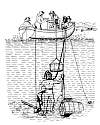 | TODAY IN SCIENCE HISTORY NEWSLETTER - 14 JUNE |
| Feature for Today |
 On 14 Jun 1736, Charles-Augustin de Coulomb was born, whose contributions to the measurement of electrical charge were recognized by the naming of its unit after him. On 14 Jun 1736, Charles-Augustin de Coulomb was born, whose contributions to the measurement of electrical charge were recognized by the naming of its unit after him.A biography of Charles-Augustin de Coulomb in Pioneers of Electricity (1890) is very informative on the diverse interests of this remarkable scientist. Among the interesting facts you probably did not know about him was that he was sent to the prison of the Abbaye over a report on a canal! Of course, as you would expect, his introduction of measurement to the study of electrical charge is a large part of this biography of this remarkable person - another scientist about whom you can learn some background you perhaps would never have otherwise known he studied (for example, about the sap of poplar trees!). |
| Book of the Day | |
| |
| Quotations for Today | |
 | "Our brains seem to be organised to make random comparisons of the contents of our memories. Daydreaming allows the process to go into free fall. Suddenly, there is a new idea, born with intense excitement. We cannot organise this process but we can distort or even defeat it." (Commenting that creativity is not a method that can be learnt and taught.) |
 | "A single kind of red cell is supposed to have an enormous number of different substances on it, and in the same way there are substances in the serum to react with many different animal cells. In addition, the substances which match each kind of cell are different in each kind of serum. The number of hypothetical different substances postulated makes this conception so uneconomical that the question must be asked whether it is the only one possible. ... We ourselves hold that another, simpler, explanation is possible." |
 | "Moreover, the sciences are monuments devoted to the public good; each citizen owes to them a tribute proportional to his talents. While the great men, carried to the summit of the edifice, draw and put up the higher floors, the ordinary artists scattered in the lower floors, or hidden in the obscurity of the foundations, must only seek to improve what cleverer hands have created." |
| QUIZ | |
| Before you look at today's web page, see if you can answer some of these questions about the events that happened on this day. Some of the names are very familiar. Others will likely stump you. Tickle your curiosity with these questions, then check your answers on today's web page. | |
| Births | |
 |  On 14 Jun 1864, the German psychiatrist, who recognized a disease named after him, was born. In Nov 1901, a 51-year old female patient with signs of dementia had been admitted to the Frankfurt hospital where this doctor was working. At a meeting German psychiatrists in Nov 1906, he reported on this patient. The title of his lecture was �ber eiene eigenartige Erkrankung der Hirnrinde (On a peculiar disorder of the cerebral cortex): Presenile dementia is a progressive, degenerative disorder that affects the brain. The first symptoms are loss of memory, inability to think and understand and gradual behaviour changes. Death follows in from 8 to 20 years. Presenile dementia is now known by the name of this psychiatrist. On 14 Jun 1864, the German psychiatrist, who recognized a disease named after him, was born. In Nov 1901, a 51-year old female patient with signs of dementia had been admitted to the Frankfurt hospital where this doctor was working. At a meeting German psychiatrists in Nov 1906, he reported on this patient. The title of his lecture was �ber eiene eigenartige Erkrankung der Hirnrinde (On a peculiar disorder of the cerebral cortex): Presenile dementia is a progressive, degenerative disorder that affects the brain. The first symptoms are loss of memory, inability to think and understand and gradual behaviour changes. Death follows in from 8 to 20 years. Presenile dementia is now known by the name of this psychiatrist. Can you name this man? Can you name this man? |
 |  Charles-Augustin de Coulomb was born 14 Jun 1736, the French physicist who is best known for the formulation of Coulomb's law. In 1777, he invented a torsion balance which he subsequently modified for electrical measurements. He also did research on friction of machinery, on windmills, and on the elasticity of metal and silk fibres. Charles-Augustin de Coulomb was born 14 Jun 1736, the French physicist who is best known for the formulation of Coulomb's law. In 1777, he invented a torsion balance which he subsequently modified for electrical measurements. He also did research on friction of machinery, on windmills, and on the elasticity of metal and silk fibres. What is Coulomb's law? What is Coulomb's law? |
| Deaths | |
 |  A Scottish engineer (1888-1946) was the first man to televise outline pictures of objects (1924) followed the next year by recognizable human faces. By 1926, he was able to demonstrate TV for moving objects at the Royal Institution, London. He demonstrated colour television in 1928. The British Broadcasting Corporation (BBC) formed in 1936 considered his system, but it was the competing system of Marconi Electric and Musical Industries that the BBC adopted in Feb 1937. He continued experimenting, and was reported to have completed his researches on stereoscopic television in 1946. A Scottish engineer (1888-1946) was the first man to televise outline pictures of objects (1924) followed the next year by recognizable human faces. By 1926, he was able to demonstrate TV for moving objects at the Royal Institution, London. He demonstrated colour television in 1928. The British Broadcasting Corporation (BBC) formed in 1936 considered his system, but it was the competing system of Marconi Electric and Musical Industries that the BBC adopted in Feb 1937. He continued experimenting, and was reported to have completed his researches on stereoscopic television in 1946.  Can you name this man? Can you name this man? |
| Events | |
 On 14 Jun 1972, a well-known insecticide was banned from use in the U.S. after 31 Dec 1972, by executive order of the Environmental Protection Agency. On 14 Jun 1972, a well-known insecticide was banned from use in the U.S. after 31 Dec 1972, by executive order of the Environmental Protection Agency. What insecticide was banned? What insecticide was banned? | |
 |  On 14 Jun of a certain year, the first U.S. patent for a practical underwater diving suit was issued to Leonard Norcross of Dixfield, Me. Calling it a "water-dress," he designed an airtight rubber outfit with a brass helmet connected via a rubber hose to an air pump on a boat. To reduce buoyancy, the feet were weighted with lead shot. On 14 Jun of a certain year, the first U.S. patent for a practical underwater diving suit was issued to Leonard Norcross of Dixfield, Me. Calling it a "water-dress," he designed an airtight rubber outfit with a brass helmet connected via a rubber hose to an air pump on a boat. To reduce buoyancy, the feet were weighted with lead shot. In what decade was this patent issued? In what decade was this patent issued? |
 On 14 Jun 1892, a number of patents were issued to the same man for a variety of inventions, U.S. Nos. 476,983 to 476,993. They were for, respectively, a "Pyromagnetic Generator," an "Expansible Pulley," a "Trolley for Electric Railways," a "Means for "Propelling Electric Cars," an "Electric Locomotive," a "Lightning-Arrester," a "Conductor for Electric Railways," an "Electric Meter," a "Method of and Apparatus for Separating Ores," an "Incandescent Electric Lamp" and an "Electric-Arc Lamp." On 14 Jun 1892, a number of patents were issued to the same man for a variety of inventions, U.S. Nos. 476,983 to 476,993. They were for, respectively, a "Pyromagnetic Generator," an "Expansible Pulley," a "Trolley for Electric Railways," a "Means for "Propelling Electric Cars," an "Electric Locomotive," a "Lightning-Arrester," a "Conductor for Electric Railways," an "Electric Meter," a "Method of and Apparatus for Separating Ores," an "Incandescent Electric Lamp" and an "Electric-Arc Lamp." Can you name the inventor? Can you name the inventor? | |
| Answers |
When you have your answers ready to all the questions above, you'll find all the information to check them, and more, on the June 14 web page of Today in Science History. Or, try this link first for just the brief answers. Fast answers for the previous newsletter for June 13: radio waves; John Augustus Roebling; bees; the study of rock minerals by viewing thin slices of rock under a microscope; Gossamer Albatross; the walking gait of individuals, to distinguish between actual and spurious limps in damage claims for injuries; the decade including the year 1913. |
| Feedback |
 If you enjoy this newsletter, the website, or wish to offer encouragement or ideas, please send feedback by using your mail reader Reply button. If you enjoy this newsletter, the website, or wish to offer encouragement or ideas, please send feedback by using your mail reader Reply button. |
--
If you do not want to receive any more newsletters, Unsubscribe
To update your preferences and to unsubscribe visit this link


Δεν υπάρχουν σχόλια:
Δημοσίευση σχολίου